Kaimoor Wildlife Sanctuary is a protected area in district Mirzapur and Sonbhadra of Uttar Pradesh.The Ministry of Environment, Forests & Climate Change published the draft notification for declaration of extent and boundaries for the 1 Km eco-sensitive zone around the sanctuary and invited Suggestions and Objections from public within 60 days. The gazette notification was dated 22nd September, 2015, and the MOEFCC websites states it was uploaded on 6th October, 2015.
Vindhyan Ecology and Natural History Foundation (Vindhya Bachao Abhiyan) submitted a detailed representation on the shortcomings in the notification and proposed several suggestions. You may download the full report as PDF from here or see
below the html version of the same representation.
This Representation is endorsed by the following individual experts and organizations:
- Dr. Asad Rahmani, Wildlife Expert
- Mr. Mike Pandey, Wildlife Expert and Filmmaker
- Prof. A.S. Raghubanshi, Director, Institute of Environment and Sustainable Development, Banaras Hindu University
- Ms. Parul Gupta, Environmental Lawyer
- Earth Matters Foundation, New Delhi
- Sanctuary Asia, Mumbai
- Vindhyan Ecology and Natural History Foundation, Mirzapur
A. Map of the Proposed Kaimoor Eco-Sensitive Zone (ESZ) as per the Draft Notification
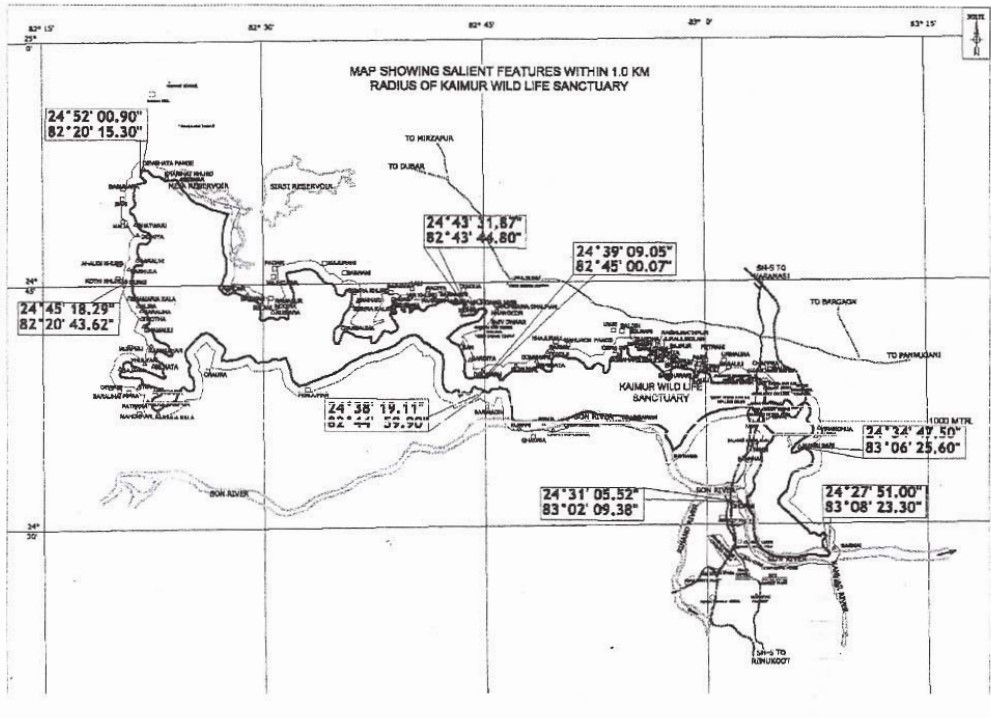 Figure 1 Kaimoor Wildlife Sanctuary with 1 km eco-sensitive zone, adopted from the draft notification S.O. 2601
Figure 1 Kaimoor Wildlife Sanctuary with 1 km eco-sensitive zone, adopted from the draft notification S.O. 2601B. Shortcomings in the Draft Notification
The proposed Kaimoor Wildlife Sanctuary Eco-sensitive zone is highly inadequate and seems to lack any scientific validation while declaring the same. It came as a great disappointment to the ecologists and nature lovers who are aware of the natural heritage of national importance that this entire region holds. The draft ignores the critical wild habitats, corridors, connecting forests, ecotones and other such areas that must be protected. We are of the strong belief that the entire Kaimoor Wildlife Division and Mirzapur Forest Division along with neighboring areas of wilderness should be declared as a Biosphere Reserve owing to its rich diversity of medicinal plants and wildlife. However, for the time being we are presenting only our critique of this present notification of Eco-Sensitive Zone. We are of the considered opinion that it has been prepared in haste and without any application of mind because of the following reasons:
1. The importance of adjacent forests ignored
The present proposal of 1 km ESZ is negligible and unlikely to serve the purpose for which any ESZ is declared. The reason is that the Kaimoor Wildlife Sanctuary (KWLS) is surrounded by several forests, many of which are Notified Reserve Forests, that are rich in diversity, and that extend beyond 10 km. Another fact that cannot be ignored is that the Kaimoor Wildlife Sanctuary is a heavily disturbed landscape that has numerous human settlements under the Forest Rights Act, 2006. The forests are under huge pressure from agricultural expansion within the sanctuary. It is all these forests in the fringe areas that act as a cushion or extended habitat for wildlife, and because of which the survival of animals has been made possible. For example, on the north-eastern boundary of KWLS is Patehara Forest Range which is a critical forest range and home to a variety of animals, including Schedule I species like Sloth Bear, Chinkara, Blackbuck, Monitor Lizard, and Mugger Crocodile. In the wildlife census of Patehara Forest Range in the years 2009, 2011 and 2013, the Mirzapur Forest Division have also reported the presence of Swamp Deer. Similarly, the dense Drammadganj Forest Range lying to the north-western boundary is not only one of the finest wildlife habitats we have surveyed but it also connects Kaimoor WLS directly with Ranipur WLS (Banda, U.P.) through a continuous stretch of mountainous forests. Such areas need to be given special protection, however, the draft notification makes no mention of this.
The 1 km ESZ that the draft notification proposes mostly constitutes such areas that are already notified Reserve Forests which have higher regulatory provisions. In such a case, what is the justification of declaring the ESZ within a Reserve Forest and what special protection it will provide to wildlife remains unanswered. To a large extent it appears that the draft ESZ has a serious lack of empathy towards the ecology of the region and the rich biodiversity that this landscape holds.
We are of the very strong view that such forests adjacent to KWLS need a stronger protection regime as these forests are facing severe threats from mining, fuelwood collection and other anthropogenic pressures. Along with all the adjacent forests, it is crucial that the wildlife corridors are protected.
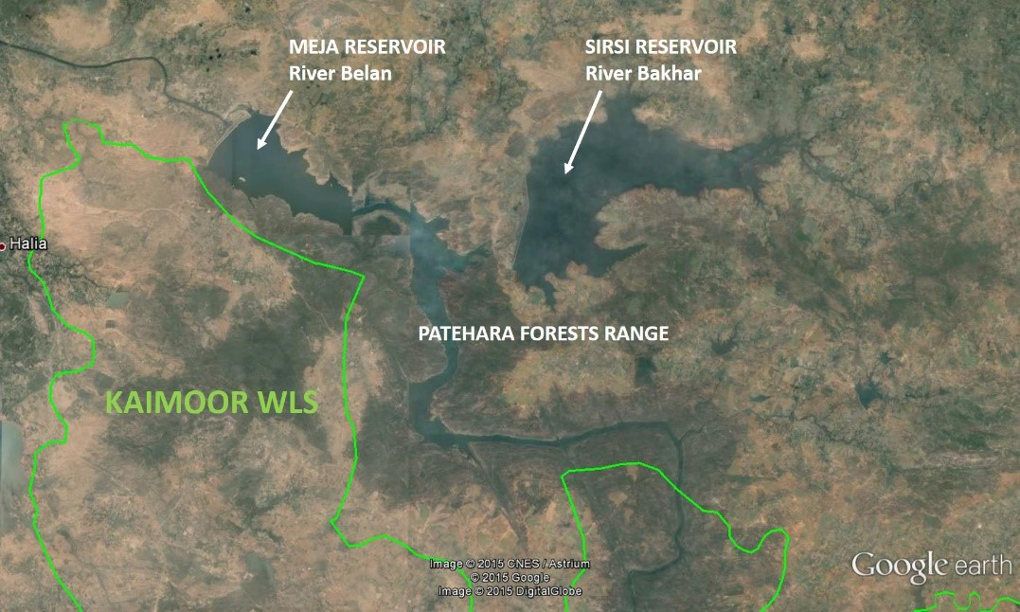
Figure 2 Satellite Image showing the location of Meja Dam and Patehara Forest Range adjacent to KWLS
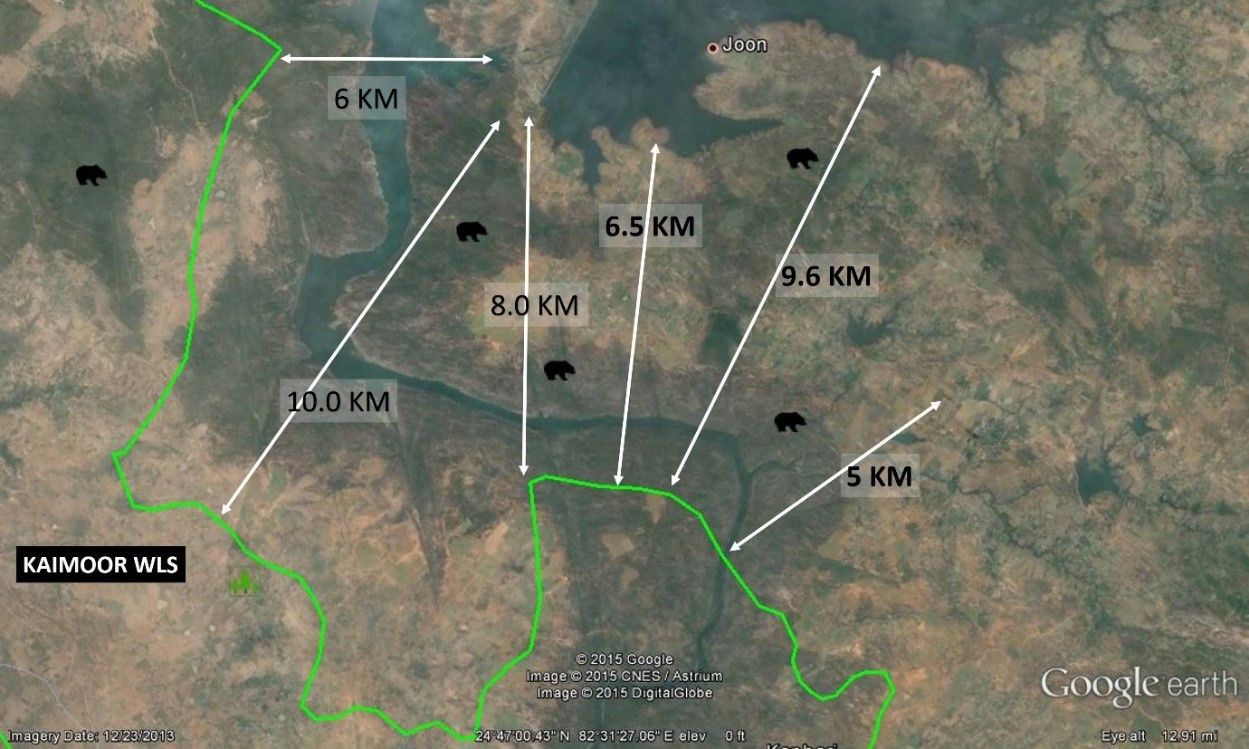
Figure 3: Patehara Forest Range (North-Eastern Boundary of KWLS, the black icons shows the aras up to which presence of sloth bears are confirmed)
2. The ecological importance of River Belan, Son and other tributaries ignored
River Belan is known as the site for one of the ancient civilizations of India. The entire basin is globally renowned for its ancient rock paintings, and Paleolithic to Neolithic artifacts. The fact is that this amazing river, and several other streams and tributaries, originate from the KWLS and its surrounding areas, and the ecological sensitivity of this region must be taken into consideration while making any decision on its management. Similarly, in the area between the southern boundary of KWLS and river Son, that also forms part of Son Gharial Sanctuary, innumerable streams originate and flow through the area making it a sensitive ecosystem called an ‘ecotone’.
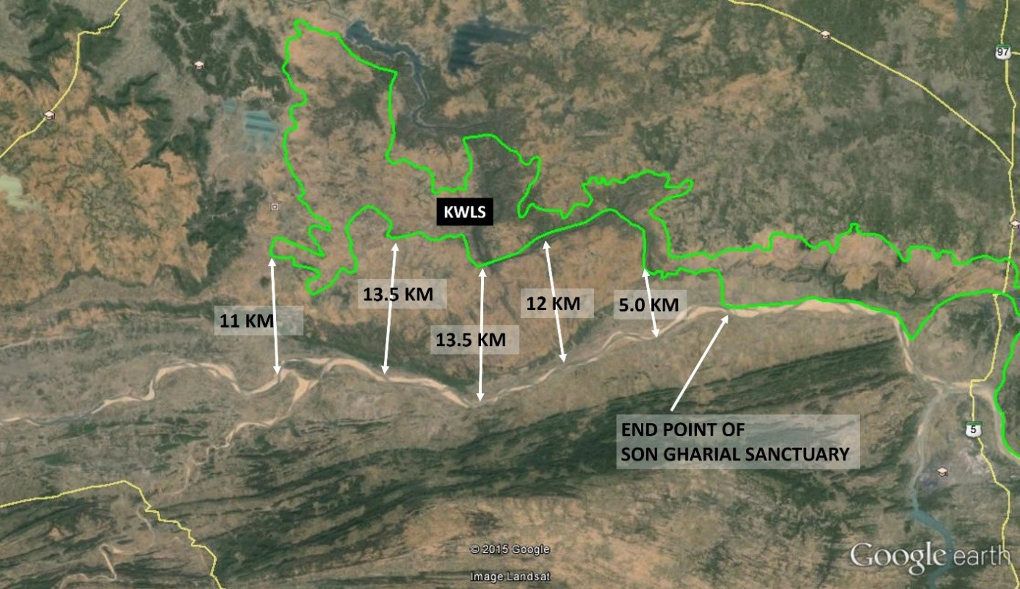
Figure 4: Son Gharial Sanctuary (South-West Boundary of KWLS)
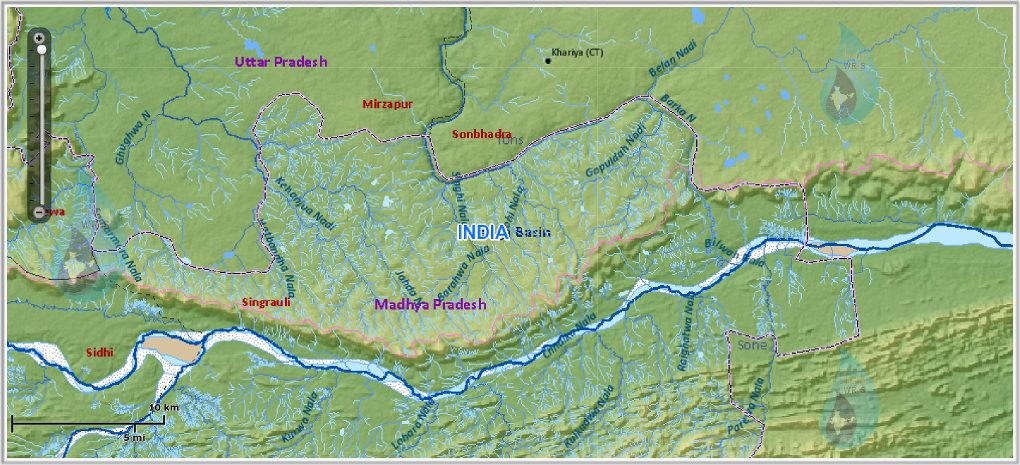
Figure 5: The region between Son Gharial Sanctuary and KWLS is origin point of several rivers. Adopted from WRIS-NRSC, Ministry of Water Resources
3. Wildlife corridors with neighboring PAs & wildlife habitats ignored
The continuous stretch of forests running parallel to Son river which extends up to Kaimoor WLS-Bihar is a critical wildlife corridor which is part of this important ecotone. The same can be understood from the following map.
Kaimoor-Son-Kaimoor Corridor
The Kaimoor Wildlife Sanctuary of Bihar lies just 38 km downstream of river Son and shares the boundary with Uttar Pradesh’s Chandoli and Sonbhadra District.
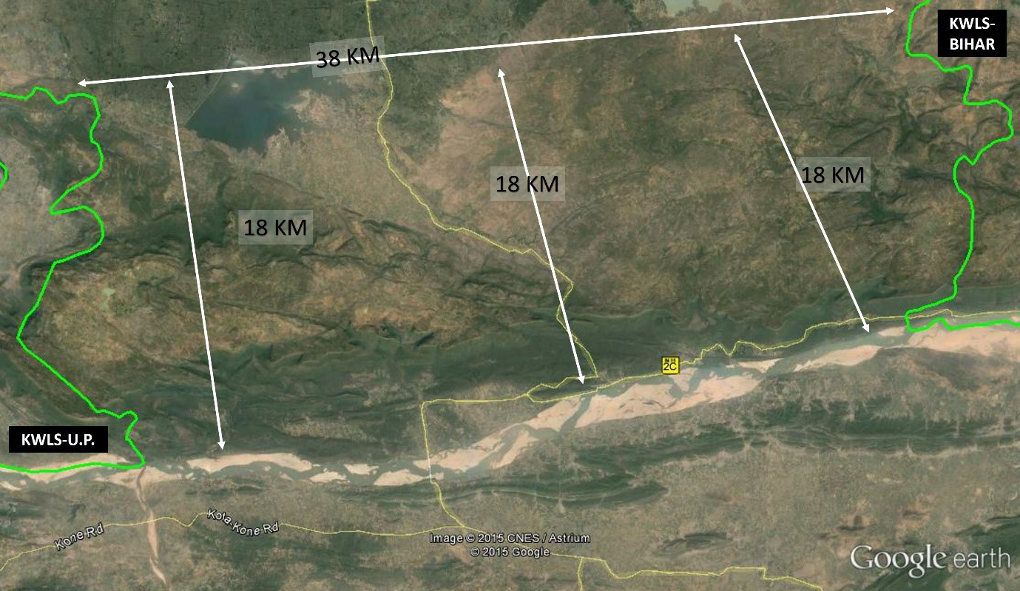
Figure 6: Southern Tip of Kaimoor WLS-U.P. and Kaimoor WLS-Bihar-in between the continuous stretch of forests along River Son
The Kaimoor WLS of Bihar shares the southern, south eastern and western boundaries with Uttar Pradesh. In the draft notification for Eco-sensitive zone of Kaimoor WLS-Bihar, the Bihar government did not declare the ESZ as it was stated that the region is part of Uttar Pradesh. The same fact is clearly stated in the gazette notification for Kaimoor-WLS-Bihar vide S.O. 274 (E) dated 28th January, 2015. Therefore, it is the responsibility of the state of U.P. to declare the forests and river adjoining the Kaimoor WLS of Bihar under the ESZ.
We are aware that the western boundary of Kaimoor WLS-Bihar constitutes very dense forests of the Chandoli district, with great diversity of flora and fauna, and extends to Chandraprabha WLS. These forests deserve to be protected not only as ESZ but under a stronger regulatory framework. However, in the context of only Kaimoor WLS-U.P. we must consider the wildlife corridor as shown above which is a very important link between the two sanctuaries, which were once part of a single conitguous landscape. We are of the very strong view that this stretch has all the qualities to be included within the Sanctuary, but ignorance of this area in the ESZ draft notification is a great disappointment.
Halia-Drammadganj-Ranipur Corridor
Ranipur Wildlife Sanctuary falls in Banda district of Uttar Pradesh and is a biodiversity rich Protected Area of similar landscape as Kaimoor. Drammadganj is the adjacent Forest Range lying towards the western boundary of the KWLS and is surrounded by hilly escarpments. The Drammadganj range is known for leopards, crocodiles and bears. The villages of Patehara and Drammadganj are active sites of man-animal conflicts as the range forms an integral part of the wildlife corridor that extends up to Ranipur WLS. The following satellite image also makes it very clear how this 2 km. wide and approximately 145 km. long stretch of forests from Drammadganj Forests is a very critical to the movement of wildlife. The mountainous forests of this stretch are also sloth bear habitat, which are reported from nearly every village near to the stretch.
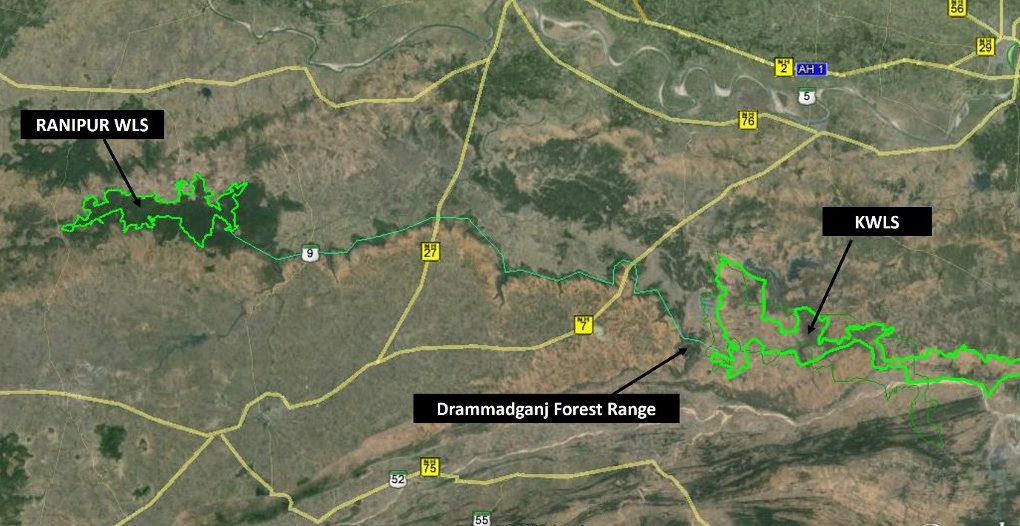
Figure 7: The 2 km wide 145 Km long stretch of forests between Drammadganj Forests and Ranipur WLS
Kaimoor-Mirzapur-Chandraprabha Corridor
The DFO-Mirzapur Forests Division in reply to our representation on the decline of wildlife in Mirzapur Forest Division, dated 12.12.2014, has specifically stated that there is continuous movement of wild animals between Kaimoor WLS and Chandraprabha WLS through the Mirzapur Forests Division. It is very clear that the Forest Department is aware of this fact and it was their duty to include such corridors as which exist between Mirzapur Forest Division (which constitutes 8 Forest Ranges- Marihan, Sukrit, Drammadganj, Patehara, Chunar, Mirzapur Wyndhamfall and Lalganj) and Kaimoor WLS. Yet, this notification is completely silent on this issue and takes no cognizance of the importance of these corridors.
3. Guideline for declaring Eco-Sensitive Zones not followed
i) Why the decrease in the distance than usual 10 Km ESZ?
The original proposal for the declaration of Eco-sensitive zones stipulated the notification of areas upto 10 km. from the Protected Area or, in some cases, even beyond. However, various states submitted that many human habitations, including important cities, would in this case come under the purview of Eco-sensitive zone, and that would adversely affect their development. The Guidelines for Declaration of Eco-Sensitive Zones Around National Parks and Wildlife Sanctuaries, Ministry of Environment & Forests, February, 2011 states:
4.1 Many of the existing Protected Areas have already undergone tremendous development in close vicinity to their boundaries. Some of the Protected Areas actually lying in the urban setup (Eg. Guindy National Park, Tamil Nadu, Sanjay Gandhi National Park, Maharashtra, etc). Therefore, defining the extent of Eco sensitive zones around Protected Areas will have to be kept flexible and Protected Area specific. The width of the Eco-Sensitive Zone and type of regulations will differ from Protected Area to Protected Area. However, as a general principle the width of the Eco-Sensitive Zone could go up to 10 kms around a Protected Area as provided in the Wildlife Conservation Strategy-2002.
4.2 In case where sensitive corridors, connectivity and ecologically important patches, crucial for landscape linkage, are even beyond 10 kms width, these should be included in the Eco-Sensitive Zone.
4.3 Further, even in context of a particular Protected Area, the distribution of an area of Eco-Sensitive Zone and the extent of regulation may not be uniform all around and it could be of variable width and extent
In this present case, the only nearby town Robertsganj is approximately 3 km. from the northern tip of the eastern zone of the Wildlife Sanctuary. This comprises hardly 2 km of the approximately 350 km peripheral boundary of KWLS. Sharing a miniscule percentage of the KWLS boundary with a town can’t be a deprecating reason for applying a uniform 1 km. ESZ across the Sanctuary. Except this semi-urban town of Robertsganj, there is hardly any city even within 35 km of KWLS.
As far as the question of human habitation, the habitations inside the KWLS and adjacent forest areas are rural-agricultural in nature and can co-exist with the Protected Areas. Here, effective regulation can reduce disturbance to wild habitats. Such human settlements are adapted to the ecosystem, already living in harmony with nature for years, and won’t cause any major impact on the Protected Areas if efficiently regulated.
Therefore, there is no justification to why a uniform 1 km ESZ has been proposed around the KWLS, a critical habitat for wild flora and fauna.
ii) No Reverence to National Wildlife Action Plan
The National Wildlife Action Plan (NWAP) 2002-2016 indicates that "Areas outside the protected area network are often vital ecological corridor links and must be protected to prevent isolation of fragments of biodiversity which will not survive in the long run. Land and water use policies will need to accept the imperative of strictly protecting ecologically fragile habitats and regulating use elsewhere. "
The Action Plan also indicates that "All identified areas around Protected Areas and wildlife corridors to be declared as ecologically fragile under the Environment (Protection) Act, 1986."
In the present notification, all these provisions have been ignored.
C. Suggestions for Improvement of the Notification
We are of the strong view that given the unique landscape of Vindhyas in Mirzapur, Sonbhadra and adjoining districts, which are fast getting fragmented, there is a need to implement stronger regulatory framework for the protection of the forests without affecting economic services to the local people. While notifying new Protected Areas and extending boundaries of existing Protected Areas can be a good step, the entire region needs to be protected as a single entity to ensure the survival of the biodiversity of this ecosystem. The Vindhyan forests of Sonbhadra, Mirzapur, Chandoli and adjoining districts are known for medicinal plants that can be a huge economic boost to the people and add revenue to government. One suggestion is to declare the entire region as a Biosphere Reserve with the Reserve Forests being the satellite core areas. However, in context of the immediate notification which relates to only Kaimoor Wildlife Sanctuary-Mirzapur and Sonbhadra, we suggest the following amendments:
i) The ESZ must include the totality of all the forests and rivers adjoining/neighboring the KWLS boundary as these areas are an integral part of Kaimoor WLS and are freely used by wild animals for habitat, prey and drinking water sources. The extent of the ESZ must be 5 km from the boundary of such forests and rivers. For eg. The entire Patehara Forest Range and Drammadganj Range plus 5 km from the outer boundary should be included in the ESZ.
ii) The ‘ecotones’ in and around the Sanctuary area must be protected with the highest possible provision as they are not only rich ecosystems but have significant importance in maintaining the ecological balance of the entire region. For example, the region between Belan River-KWLS and Son River-KWLS must be protected from any type of human interference.
iii) The ESZ must include the reservoirs which are within 10 Km of the KWLS which includes Meja Reservoir, Sirsi Reservoir, Sukhra Reservoir and other small water bodies as these water bodies are known to harbour Mugger Crocodiles and turtles and are also important sources of drinking water for wild animals. Intensive forestation of local species must be taken up to improve the connectivity. Special care must be taken that the reservoirs are not fenced and any concrete construction does not take place on the banks as these are important nesting zones for crocodiles and turtles. Fishing here must be prohibited, and crocodile and turtle nesting sites must be assessed with help of experts from institutes like the Wildlife Institute of India, National Centre for Biological Sciences.
iv) Wildlife Corridors between the adjoining forest ranges, sanctuaries and water bodies must be protected. The 2 km wide stretch of mountainous forests between Drammadganj Range and Ranipur WLS, the 18 km-wide stretch of forests between Kaimoor WLS-UP and Kaimoor WLS-Bihar along the northern bank of River Son must be protected. A separate assessment of important wildlife habitats and corridors must be prepared in consultation with the Forest Department of Madhya Pradesh and Chhattisgarh for identification of ESZ south of River Son.
v) Agricultural activities must be regulated inside the Reserve Forests and strict action must be taken on any encroachments or illegal possession of land. The rights of traditional forest dwellers and tribal people must be protected and they should be made active participants and stakeholders in the management of forest resources. A wildlife task force comprising members from each village, with equal participation of women, must be formed under guidance of local environmental NGOs, eco clubs of nearby schools/colleges and forest staff.
vi) The grasslands and scrublands are also an important ecosystem in the Vindhyan landscape. They are often seen as barren land by the revenue department though that is not true. They play a vital ecological role and the diversion of such lands for other development purposes must be prevented.
vii) Regulated grazing can be beneficial to the ecology and it is particularly true for species like Blackbuck and other herbivores that live in lightly grazed areas. Therefore, livestock grazing may be allowed in the ESZ with certain regulations.
viii) The diversity of threatened plants and animals in KWLS and adjoining forest ranges must be assessed scientifically and their habitats and corridors must be documented with help of premier wildlife institutes like Wildlife Institute of India. A strong action plan must be prepared under guidance of WII and other reputed institutions that have worked in this area for conservation of threatened taxa.
ix) Research on wild flora and fauna must be actively promoted and encouraged. The presence of Banaras Hindu University’s South Campus in Mirzapur can be beneficial, and efforts must be made to pro-actively encourage and support young researchers by uplifting the existing Forest Rest Houses, pro-actively sharing knowledge with students etc.
x) The monitoring committee must be constituted under three heads- Ecological, Social and Administrative. The three committees must be independent of each other but work in close coordination.
xi) Committee on Ecology must constitute ecological experts who are of similar grade and status of professors from Banaras Hindu University and Allahabad University who have worked in this region. This is very important as forest officers get transferred frequently and there is a great knowledge gap that leads to inefficient management of the forests and biodiversity. We suggest that 25% of the members be experts on Vindhyan ecology with proven expertise of research in this region, 25% of the members elected from local gram panchayats, 25% of the members nominated by DFO-Kaimoor Wildlife & DFO-Mirzapur and 25% representation from local NGOs working for environment & wildlife. The committee can recommend, with mutual consent, the appointment of other experts in the field such as sloth bear experts, reptilian experts, taxonomic experts etc.
Committee on Social issues can be formed on the same criteria as discussed in above para where the experts will be selected based on their experience in social science. Local institutes such as G.B. Pant Institute of Social Science, Allahabad University must be included.
The Administrative Committee can comprise different administrative officers from the State government including District Magistrates, Pollution Control Board Members, Revenue officers and other senior members of Forest Department.
xii) It has come to our notice that the adjoining forests of KWLS which comes under Mirzapur Forest Division is under immense scarcity of human resources. There is an urgent need to appoint more forest guards in Patehara and Drammadganj range as protection of these forests are very critical to the survival of wildlife in KWLS. Therefore, there must be sufficient number of forest guards and equipment be provided to them to carry out their duty effectively in such forest ranges. An independent committee must be set up by the Central Government to study the administrative functioning of the Forest Divisions and what measures are needed to correct the crisis.
xiii) The area should be under continuous monitoring for any land use change with special attention to mining, deforestation, illegal expansion of human settlements and unlawful expansion of agricultural areas with help of local remote sensing centers such as Remote Sensing Applications Centre-Lucknow. The important big mammals such as leopards, sloth bears, and swamp deer may be geo-tagged to monitor their movement in the area and understand their behavior, which will help the forest department to take required measures for protection of their habitats and corridors. Modern technology must be used suitably to maximize protection of the forests and wildlife from poachers and fuelwood mafia.
xiv) The forest department in Mirzapur is divided into Mirzapur Forests Division and Mirzapur Kaimoor Wildlife Division. While the Kaimoor Wildlife Division has jurisdiction inside the Wildlife Sanctuary, the Mirzapur Forest Division has jurisdiction over the adjoining forests of Patehara and Drammadganj Forest Range. For effective conservation and management of the wildlife of KWLS there has to be full involvement of Mirzapur Kaimoor Wildlife Division and other forest divisions such as Mirzapur Forest Division and other divisions which control the forests and wildlife of Sonbhadra and Chandoli districts.
xv) The villages in and around KWLS consist of tribal communities who are yet to be recognized as Scheduled Tribes. As the local communities are quite poor, there is an urgent requirement of initiating training centers to develop their vocational and entrepreneurial skills. The tourism to waterfalls around KWLS has the potential to be developed as eco-tourism sites and must be actively promoted at national level.
xvi) We urgently request to be granted the opportunity to represent our views before the Ministry in person before a final decision on the matter is taken.
Acknowledgements
We are grateful to Dr. Asad Rahmani (wildlife expert), Mr. Mike Pandey (Earth Matters Foundation) and Ms. Cara Tejpal (Sanctuary Asia) for their detailed review and critical inputs. Many thanks to our Advisors Dr. Laxmi Goparaju (ecologist), Parul Gupta (environmental lawyer) and Mr. Shiva Kumar Upadhyaya (senior journalist) for their suggestions and inputs in preparing this representation.
Correspondence of Author:
Debadityo Sinha
Mobile: +91-9540857338
Email:
Published by
Vindhyan Ecology and Natural History Foundation
Registered Office: Vindhya Bachao Secretariat
36/30, Shivpuri Colony, Mirzapur, U.P.-231001
Website: www.vindhyabachao.org
For endorsement of this representation, you may send the PDF as attached directly to following email address and CC it to

